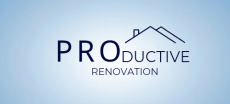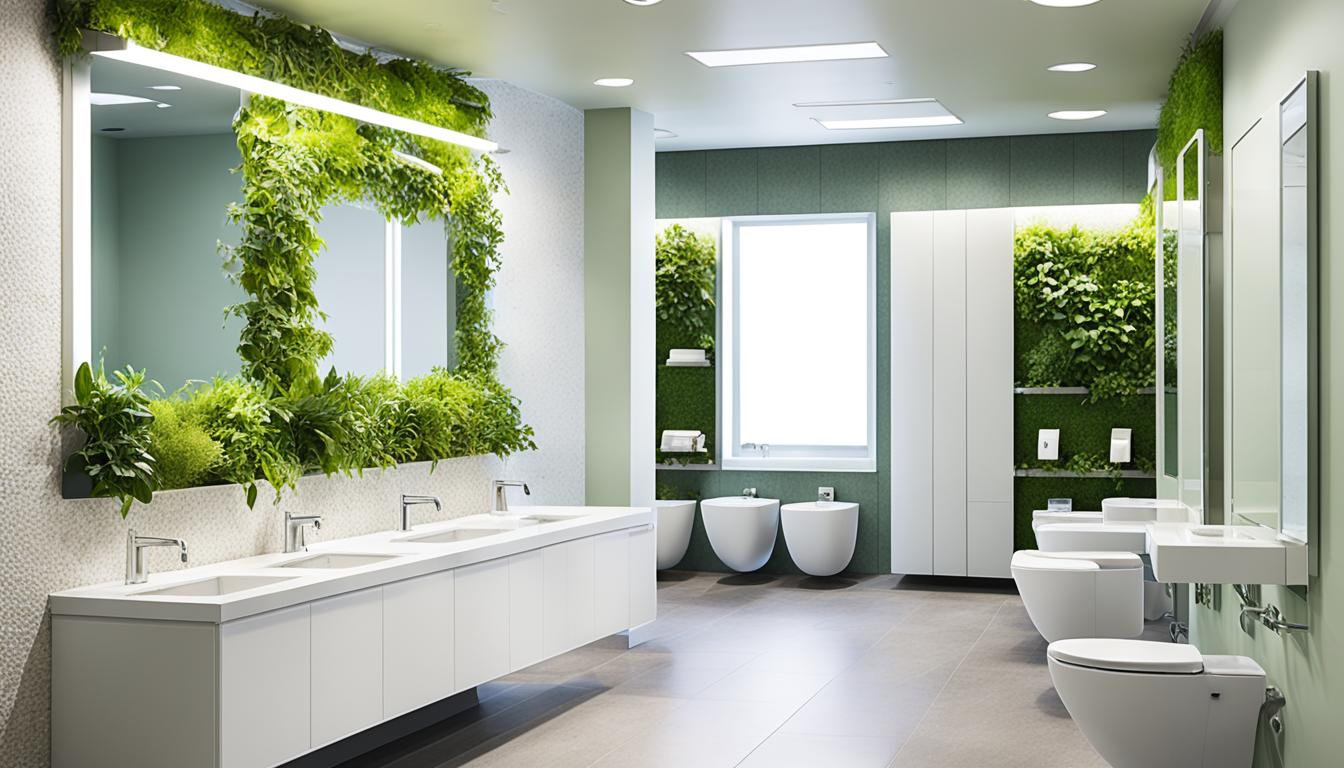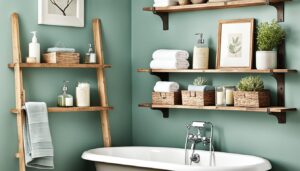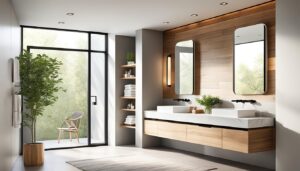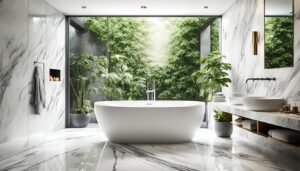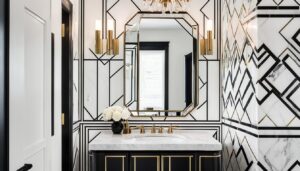Have you ever thought about how much energy your restroom uses? How its design could save or waste resources? Businesses are working hard to reduce their environmental impact while saving on utility costs. Understanding energy efficient restroom design is key. Eco-friendly bathroom solutions and sustainable design practices improve user experience. They also meet modern environmental standards.
By using green restroom technology, spaces can be more energy-efficient and attractive to eco-conscious visitors. Did you know that the number of restrooms in a workplace increases with the number of employees? This is according to OSHA. From one restroom for 1-15 employees to more for larger businesses1. Exploring new ideas and essential features in restroom design benefits the environment and operational efficiency.
Key Takeaways
- Energy efficiency in restroom design significantly reduces operational costs.
- Facilities can meet OSHA guidelines by optimizing restroom numbers based on employee counts.
- Innovative technologies facilitate sustainable lavatory practices, enhancing user experience.
- Utilizing touchless faucets and automatic lighting contributes to lower water waste and energy usage.
- Modern restroom designs can leverage high-tech solutions for improved hygiene and comfort.
- Sustainable materials are increasingly being adopted in bathroom fixtures to reduce environmental impact.
Understanding the Importance of Energy Efficiency in Commercial Restrooms
Energy efficiency is key in commercial restrooms. It affects both the environment and costs. These areas use 40% of a building’s water and cause half of the complaints2. By focusing on energy use, we can lower costs and make people happier.
Installing electronic faucets helps a lot. They cut water use by 50 to 80% compared with old-style faucets3. Choosing between hand dryers and paper towels involves looking at costs, upkeep, and eco-friendliness2. High-speed dryers use less power than traditional ones, saving more energy3.
Eco-friendly designs are becoming popular. They include automatic flush systems that save a lot of water3. Low-flow toilets also save water with each flush, making a big difference3. Plus, touchless tech helps keep restrooms clean and healthy for everyone.
Meeting the ADA standards is important for useful restrooms. This makes them accessible to more people4. Energy-efficient features also help meet eco-friendly rules and improve user experiences.
New sink designs that combine the faucet, soap, and dryer cut down on germ spread and boost efficiency2. As restroom technology gets better, businesses see lower costs and better green practices, helping the environment.
| Feature | Benefits |
|---|---|
| Electronic Faucets | Water use reduction by 50-80% |
| Automatic Flush Valves | Lower water consumption by 50-70% |
| Low-Flow Toilets | Saves 1.8 gallons per flush |
| High-Speed Hand Dryers | Uses 1500 watts instead of 2300 watts |
| Integrated Sink Systems | Fewer touchpoints and improved hygiene |
Key Features of Energy Efficient Restroom Design
To build energy smart restrooms, we must use energy-efficient lighting, high-speed hand dryers, and occupancy sensors. Energy-smart lighting cuts down on power use and makes restrooms nicer. High-speed dryers use up to 80% less power than standard ones, helping to get LEED credits5.
Occupancy sensors turn on lights only when needed. This saves energy and extends light life. All these steps make restrooms green and cost-effective over time.
| Feature | Description | Benefits |
|---|---|---|
| Energy-efficient Lighting | Utilizes LED or CFL fixtures for improved efficiency. | Decreases energy consumption and enhances restroom aesthetics. |
| High-speed Hand Dryers | Dries hands quickly while consuming minimal energy. | Reduces paper towel waste and lowers operating costs. |
| Occupancy Sensors | Detects presence to control lighting. | Minimizes energy usage and prolongs bulb life. |
Implementing Sustainable Lavatory Design Practices
Sustainable lavatory design focuses on using eco-friendly fixtures. These are important for reducing waste and saving resources. Choosing efficient toilets and motion-sensing faucets cuts down water use. This helps in making modern facilities more sustainable. For example, the average American shower uses 2.1 gallons per minute. This fact shows why it’s important to use low-flow showerheads to reduce water waste6.
Choosing the right sink materials is key in sustainable design. Molded sinks work well in schools and hospitals because they are practical and affordable7. Bio-based sinks, made from eco-friendly materials like soy, also boost sustainability. Stainless steel sinks are preferred in healthcare for their cleanliness. They stop bacteria growth, making handwashing safer7.
When picking materials for lavatories, look at style, toughness, and the environmental effect. Solid surface sinks can be customized in over 100 colors, blending design and function. Using energy-efficient solutions like these meets sustainability standards in restroom design.
Sustainability in bathrooms is more than just saving water. It’s about a complete strategy using the right materials, fixtures, and designs. Options like electric radiant flooring are efficient for heating. Combining these elements makes restrooms environmentally friendly. It meets current eco-goals, ensuring satisfaction and sustainability.
Energy Efficient Restroom Design: Innovative Technologies
New technologies are changing bathroom design, making them more efficient and enjoyable to use. Touchless faucets and sensor-driven dispensers help save water and increase cleanliness8. Restrooms are also turning smart with systems that use IoT devices. These systems monitor how many people use the bathroom and its cleaning needs in real-time8.
Smart mirrors make restrooms look better while saving energy with their LED lights and anti-fog features8. Using recycled glass and toilets that use less water helps the environment. At the same time, they add modern touches8.
Brands like Moen and Kohler lead these innovations, offering high-tech toilets priced from $2,000 to $10,000. These toilets have heated seats and flush automatically9. Such advancements focus on comfort and taking care of the planet. Plus, LED lights cut down on energy use and lower costs in commercial areas8.
Eco-Friendly Bathroom Solutions for Modern Facilities
Eco-friendly bathroom solutions are key to moving towards sustainability in today’s world. Using sustainable products like low-flow toilets helps save a lot of water. This is a big win for our planet10. Recycled tiles also play a part. They make sure up to 100% of the tiles are green without losing in style or strength11.
Moreover, choosing LED bulbs over traditional ones cuts energy use by up to 75%12.
Adding reclaimed materials like old clawfoot tubs and retro lights not only look great but reuse resources11. Plus, non-toxic, eco-friendly finishes make the air cleaner and healthier for everyone10. Bamboo floors and cork tiles are not just renewable but also great for insulation and fighting moisture in bathrooms12.
Using green cleaning products such as vinegar cuts down on harmful chemicals11. Refilling cleaners and picking eco-friendly toilet paper reduces our ecological footprint11. Lastly, motion-sensing faucets are great for saving water in line with sustainability goals10.
| Feature | Benefit |
|---|---|
| Low-flow Toilets | Saves significant water per flush and reduces daily usage12. |
| LED Lighting | Reduces energy costs by consuming 75% less energy than incandescent bulbs12. |
| Reclaimed Materials | Promotes sustainability by reducing demand for new resources11. |
| Green Cleaning Products | Non-toxic options ensure improved air quality10. |
Water-Saving Bathroom Fixtures: A Necessity in Today’s Restrooms
Modern bathroom designs focus on saving water and boosting energy efficiency. In homes across America, about 300 gallons of water are used every day. It’s key to choose fixtures that cut down on this usage significantly13. Low-flow toilets are a big help, slashing water use by 60%. They use just half the water that standard models do14. By selecting these, families can see lower utility bills and help the environment at the same time15.
High-Efficiency Toilets (HETs) only need 1.6 gallons for each flush, making them great for saving water. Adopting HETs is a smart move for energy conservation, as they also save on water heating13. Plus, water-efficient showerheads make it possible to enjoy showers while using less water. This can save about 2,700 gallons of water for a family each year13.
WaterSense-labeled faucets can save up to 700 gallons of water every year. They play a big part in conserving water13. Smart water heaters also boost sustainability. They reduce waste and make energy use more efficient, fitting perfectly into eco-friendly bathroom designs15.
These water-saving solutions not only meet regulations but also attract those who care about the planet. By including them, designers make spaces that value sustainability. They also highlight the role of saving water in creating modern, beautiful bathrooms.
Green Restroom Technology for Enhanced User Experience
Adding green tech to restrooms makes them better for users and the planet. Touchless fixtures like sensor-activated faucets cut down on germs. They also save water by turning off automatically16. Smart toilets are also getting popular for their efficient and easy-to-use design16. These updates attract people who care about health and comfort today.
Good ventilation systems help keep the air clean, taking away pollutants. By 2024, we’ll see more eco-friendly fixtures and lights that save energy. This shows careful planning in restroom designs17. Smart mirrors give users up-to-date info on restroom conditions. This improves their visit and encourages cleanliness16.
Using systems that monitor how full a restroom is ensures cleaning happens when needed. This saves resources and cuts costs16. Water reclamation systems reuse sink water for flushing toilets, lowering water use16. These steps show that making users happy goes hand in hand with green design.
The need for green restroom tech is growing. It leads to more efficient and sustainable operations. IoT devices give insights on how restrooms are used, helping make smart choices for people and nature. Smart tech in restrooms not only saves money by reducing waste but also helps the environment1817.
In conclusion, green restroom tech boosts user experience with better hygiene and comfort. It also aligns with sustainable design goals that matter more and more today.
Environmentally Conscious Restroom Design Principles
Using eco-friendly design in restrooms boosts sustainability. Natural light cuts down on artificial lighting and makes spaces more pleasant. Using recycled materials and safe finishes betters indoor air and lessens environmental harm19.
Efficient use of water is also key. Low-flow toilets, for example, use up to 60% less water per flush. This helps meet water-saving goals19. Rainwater harvesting can also reduce water use by up to 50,000 liters annually for a home19.
Proper ventilation is critical for preventing mold and mildew19. Energy-saving LED lighting lowers power use and makes public restrooms safer and more welcoming20.
Composting toilets offer a sustainable option by turning waste into compost over time. This approach is more eco-friendly than standard toilets21. Smart technologies can also lead to water savings of 14% to 20%19.
Eco-friendly restroom designs are key for sustainability. They help save energy, improve experiences, and support ecological goals. Such designs bring long-term advantages and support global sustainability efforts.
Energy-Efficient Plumbing Solutions in Commercial Restroom Design
Energy-efficient plumbing is key for better restroom design. It saves a lot of water in commercial places. The U.S. uses about 322 billion gallons of water every day. It’s shocking that 25% gets wasted in buildings due to old plumbing22. New plumbing fixtures like low-flow toilets help a lot. They use only 1.28 gallons per flush, unlike the old 3.5 gallons. This switch can save an average household more than $100 each month on water bills23. It also helps save water.
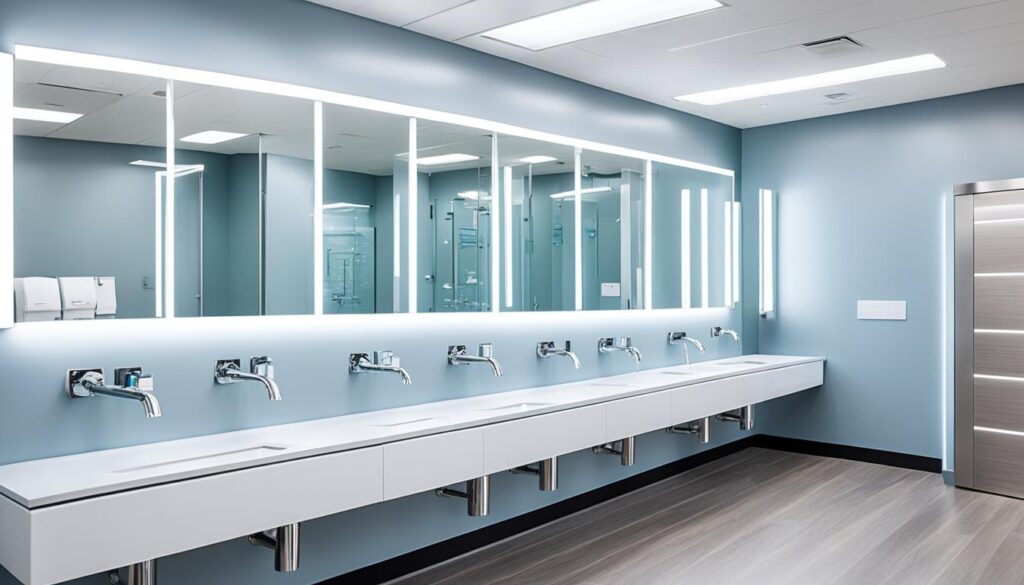
Other upgrades include aerating low-flow showerheads and efficient faucets, cutting down water use. For example, faucets now use just 1.5 gallons per minute, down from 2.2 gallons2322. Recirculating hot-water systems give hot water right when needed, without wasting23. Low-flow urinals are another game-changer, using as little as 0.125 gallons per flush. They play a big role in today’s restroom design, cutting down on water and energy use23.
| Fixture Type | Old Model Usage | New Model Usage | Annual Potential Savings |
|---|---|---|---|
| Toilets | 3.5 gpf | 1.28 gpf | Up to $100/month |
| Showerheads | 2.5 gpm | 1.75 gpm | Up to 2,900 gallons/year |
| Faucets | 2.2 gpm | 1.5 gpm | Varies by usage |
| Urinals | 1 gpf | 0.125 gpf | Significant annual savings |
Using these energy-saving plumbing solutions makes restrooms better for the planet. It helps businesses save money and meet tough environmental laws232224. Modern technology is vital for improving commercial restrooms.
Achieving LEED Certification with Sustainable Restroom Design
To get LEED certification, architects should focus on sustainable restrooms that use less energy. Using eco-friendly elements like low-flow toilets and fast hand dryers boosts a building’s efficiency. It also cuts down on energy use. Studies show LEED-certified homes can use up to 60 percent25 less energy than others.
Sustainable restroom design does more than save energy; it makes people happier and attracts young workers who love the planet. Research from 2015 shows that being green increases tenant satisfaction through better use of energy26. Clearly, projects that start with green design can reach their goals while building a good community reputation.
Upgrading to eco-friendly restroom tech, like sensor faucets and soap dispensers, reduces waste and costs. Newer hand dryers are also more energy-efficient, saving money26. Adding smart lights and sensors cuts down on energy use even more.
Designing restrooms to meet LEED standards boosts a building’s efficiency and can earn valuable LEED credits. About 35% of LEED credits are tied to fighting climate change. Energy-saving and water-conservation strategies can improve chances for LEED certification27. Using resources like this, architects can show the perks of their green choices.
Conclusion
Modern facilities focus on energy-efficient restroom design to reduce their environmental impact and improve user experiences. Incorporating sustainable practices allows businesses to adopt green solutions. This matches consumer expectations and follows regulatory guidelines. High-speed, energy-efficient hand dryers use 80 percent less energy than old models. They are key in cutting energy use in commercial bathrooms28.
Looking ahead, choosing sustainability fits with laws like California’s Title 24 energy regulations. It also shows companies are committed to protecting the environment. Adding things like low-flow fixtures, sensors that detect people, and natural airing makes restrooms more sustainable. These steps help earn green certifications like LEED29 and TRUE Zero Waste28.
To achieve eco-friendly restroom design, we need new technologies and a dedication to keeping spaces clean and satisfying for users. This focus can greatly improve restroom conditions, making them more accepted by users and more kind to the Earth. Choosing the right materials and smart design will make energy-efficient restrooms a norm in public and business areas30.
FAQ
What are the benefits of energy efficient restroom design?
How can eco-friendly bathroom solutions improve restroom functionality?
What key features should I consider for sustainable lavatory design?
How do innovative technologies contribute to energy efficiency in restrooms?
Why are water-saving bathroom fixtures essential in commercial restrooms?
What principles define environmentally conscious restroom design?
How can energy-efficient plumbing solutions enhance restroom design?
What does achieving LEED certification for restroom design entail?
Source Links
- https://www.globalindustrial.com/knowledge-center/article/shop-bathroom-supplies-pedestal-sink-shower-faucet
- https://continuingeducation.bnpmedia.com/pdf/courses/L199C3276.pdf
- https://prestigedistribution.com/blogs/news/commercial-bathroom-energy-efficiency-checklist?srsltid=AfmBOopCpNj4m938Fjy39dXGQ9ovrbwm3Ns253Pn6ecMbFr1_aYq6Jkf
- https://vizilok.com/blogs/news/restroom-requirements-for-commercial-buildings?srsltid=AfmBOop_jWE8TF-2rAoq3z86cJe5oH3nvTjY3htRlrFTMzTStJ8jVX9A
- https://www.bathroomcity.co.uk/blog/top-energy-saving-ideas-your-bathroom?srsltid=AfmBOop3UruySs48SrygdVdFVnJhXpuBNb_VzVv1mLNvg4yljdLBRQih
- https://www.ny-engineers.com/blog/tips-for-creating-an-eco-friendly-sustainable-bathroom
- https://www.iands.design/projects/education/article/10168434/designing-restrooms-that-are-sustainable-and-accessible
- https://sbicontractinginc.com/blog/commercial-bathroom-design-2/
- https://reolink.com/blog/smart-bathroom-technology/
- https://opalbaths.com/eco-friendly-bathroom/
- https://ofhousesandtrees.com/eco-friendly-bathrooms/
- https://www.thecontractorguysaz.com/blog/sustainable-bath-remodeling-eco-friendly-choices
- https://blog.mrsteam.com/water-efficient-fixtures
- https://lacarpet.com/blogs/eco-friendly-bathrooms-innovative-fixtures-to-save-water-and-money/
- https://www.stansac.com/blog/eco-friendly-bathroom-upgrades
- https://traxinsights.com/2024/05/23/restroom-monitoring-technology/
- https://blog.bathselect.com/top-commercial-restroom-design-trends-for-2024-embracing-wellness-sustainability-and-technology/
- https://envirorental.earth/green-technology-for-short-term-rentals/
- https://www.designacrolect.com/post/save-water-in-style-eco-friendly-bathroom-designs-to-try
- https://www.facilitiesnet.com/plumbingrestrooms/contributed/3-Steps-to-Green-Energy-Efficient-Public-Bathrooms–41785
- https://www.homebiogas.com/blog/all-about-eco-toilets/
- https://gbdmagazine.com/green-plumbing-solutions/
- https://esub.com/blog/top-5-water-saving-plumbing-fixtures/
- https://www.finehomebuilding.com/2023/05/31/understanding-toilet-design-and-efficiency
- https://www.energy.gov/energysaver/leed-certified-homes
- https://www.bobrick.com/designing-for-authentic-sustainability/
- https://romtec.com/blog-categories/sustainable-building-design/
- https://continuingeducation.bnpmedia.com/courses/excel-dryer-inc/3-keys-to-commercial-restroom-design-safety-sustainability-and-savings/4/
- https://www.alconlighting.com/blog/lighting-design/commercial-restroom-lighting-design-guide/
- https://sbicontractinginc.com/blog/public-restroom-design/
